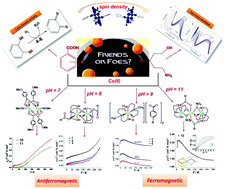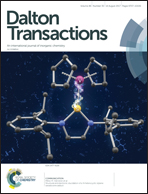Aminoalcohols and benzoates-friends or foes? Tuning nuclearity of Cu(ii) complexes, studies of their structures, magnetism, and catecholase-like activities as well as performing DFT and TDDFT studies†
Abstract
Herein, the coordination chemistry of a series of Cu(II) complexes of various aminoalcohol and benzoate ligands was explored. The pH-dependent reactions of copper(II) salts with propanolamine (Hpa), N-methyl diethanolamine (H2mdea), triethanolamine (H3tea), and nbutyl-diethanolamine (H2budea) were carried out in the presence of various benzoates (benzoic acid, 2-hydroxy benzoic acid, 4-hydroxy benzoic acid, 3-methoxy benzoic acid, and 4-methoxy benzoic acid). The resulting complexes [Cu2(pa)2(benzoate)2] (1), [Cu2(pa)2(3-methoxybenzoate)2] (2), [Cu2(pa)2(4-methoxybenzoate)2] (3), [Cu2(H2tea)2(benzoate)2]·2H2O (4), [Cu2(H2tea)2(2-hydroxybenzoate)2]·2H2O (5), [Cu2(H3tea)2(4-hydroxybenzoate)2][Cu(Htea)2]·2H2O (6), [Cu(H2mdea)2][benzoate]2 (7), [Cu(H2mdea)2][4-methoxybenzoate]2 (8), [Cu(H2bdea)2][2-hydroxybenzoate]2 (9), [Cu2(benzoate)4(benzoic acid)2] (10), [Cu2(4-methoxybenzoate)4(CH3CN)2]·4CH3CN (11) and [Cu3(H2tea)2(benzoate)2(NO3)2] (12) were formed as mono-, di- or trinuclear entities depending upon the pH conditions of the reaction. The complexes were characterized employing spectral, magnetic, single-crystal X-ray and DFT/TDDFT studies. 7 and 8 exhibited emission peaks at 510 and 460 nm, respectively, in the solid-state photoluminescence (PL) spectra. The temperature variable magnetic properties of 1–12 revealed the presence of antiferromagnetic (in 1–3 and 7–11) or ferromagnetic interactions (in 4–6 and 12) with Curie constants C = 0.24 (7), 0.28 (8) or 0.35 cm3 K mol−1 (9) and Weiss constants θ = −0.34 (7), −0.32 (8) or −0.40 (9) K for the mononuclear complexes. The dinuclear complexes demonstrated J values of −89.2(2) (1), −71.1(3) (2), −59.6(1) (3), 98(1) (4), 79.1(2) (5), −85.4(2) (10) and −89.5(2) (11) cm−1. Strong ferromagnetic interactions were observed in the case of 6 (J = 172(3) cm−1 and zJ′ = 2.3(2) cm−1), which were comparable with those of 12 (J12 = 197(2) cm−1, J13 = −9.3(3) cm−1). A correlation exists between the Cu–O–Cu angle and magnetic coupling in di- and trinuclear Cu(II) complexes. Moreover, 4–6 were active catalysts for the oxidation of 3,5-DTBC to 3,5-DTBQ and showed catecholase activity in the order 4 > 5 > 6 (Kcat = 943 (4), 698 (5) and 553 h−1 (6)). This order can be rationalized in terms of the electron density on the ligand, which neutralizes the effective positive charge on Cu(II), thus forming the less or more stable intermediate. The order of catecholase activity and the electronic spectral properties of 4–6 were also investigated by DFT and TDDFT studies, respectively.

- This article is part of the themed collection: Dalton Transactions Inorganic Symposia


 Please wait while we load your content...
Please wait while we load your content...